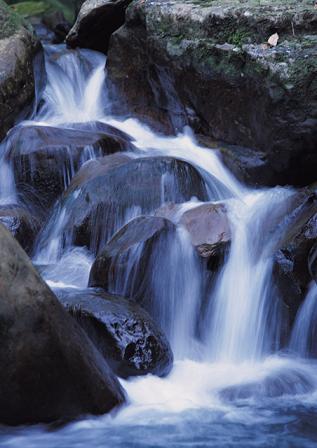| Water is the most common substance on Earth. It covers more than 70 percent of the Earth's surface. It fills the oceans, rivers, and lakes, and is in the ground and in the air we breathe. Water is everywhere.
Without water, there can be no life. In fact, every living thing consists mostly of water. Your body is about two-thirds water. A chicken is about three-fourths water, and a pineapple is about four-fifths water. Most scientists believe that life itself began in water-in the salty water of the sea.
Ever since the world began, water has been shaping Earth. Rain hammers at the land and washes soil into rivers. The oceans pound against the shores, chiseling cliffs and carrying away land. Rivers knife through rock, carve canyons, and build up land where they empty into the sea. Glaciers plow valleys and cut down mountains.
Water helps keep Earth's climate from getting too hot or too cold. Land absorbs and releases heat from the sun quickly. But the oceans absorb and release the sun's heat slowly. So breezes from the oceans bring warmth to the land in winter and coolness in summer.
|

|
Throughout history, water has been people's slave-and their master. Great civilizations have risen where water supplies were plentiful. They have fallen when these supplies failed. People have killed one another for a muddy water hole. They have worshiped rain gods and prayed for rain. Often, when rains have failed to come, crops have withered and starvation has spread across a land. Sometimes the rains have fallen too heavily and too suddenly. Then rivers have overflowed their banks, drowning large numbers of people and causing enormous destruction of property.
Today, more than ever, water is both slave and master to people. We use water in our homes for cleaning, cooking, bathing, and carrying away wastes. We use water to irrigate dry farmlands so we can grow more food. Our factories use more water than any other material. We use the water in rushing rivers and thundering waterfalls to produce electricity.
Our demand for water is constantly increasing. Every year, there are more people in the world. Factories turn out more and more products, and need more and more water. We live in a world of water. But almost all of it-about 97 percent-is in the oceans. This water is too salty to be used for drinking, farming, and manufacturing. Only about 3 percent of the world's water is fresh (unsalty). Most of this water is not easily available to people because it is locked in ice that covers Antarctica, Greenland, and the waters of the north polar region. But there is still enough to meet people's needs. There is as much water on Earth today as there was when dinosaurs inhabited the planet millions of years ago.
There is as much water on Earth today as there ever was-or ever will be. Almost every drop of water we use finds its way to the oceans. There, it is evaporated by the sun. It then falls back to Earth as rain. Water is used and reused over and over again. It is never used up.
Although the world as a whole has plenty of fresh water, some regions have a water shortage. Rain does not fall evenly over Earth. Some regions are always too dry, and others too wet. A region that usually gets enough rain may suddenly have a serious dry spell, and another region may be flooded with too much rain.
Some regions have a water shortage because the people have managed their supply poorly. People settle where water is plentiful-near lakes and rivers. Cities grow, and factories spring up. The cities and factories dump their wastes into the lakes and rivers, polluting them. Then the people look for new sources of water. Shortages also occur because some cities do not make full use of their supply. They have plenty of water but not enough storage tanks, treatment plants, and distribution pipes to meet the people's needs. As our demand for water grows and grows, we will have to make better and better use of our supply. The more we learn about water, the better we will be able to meet this challenge.
|

